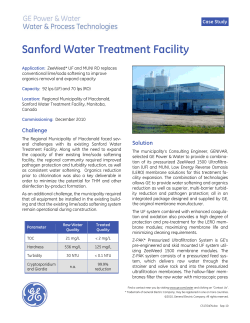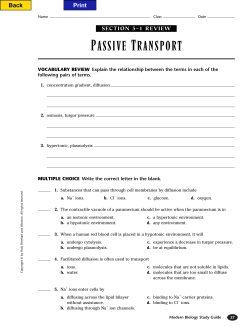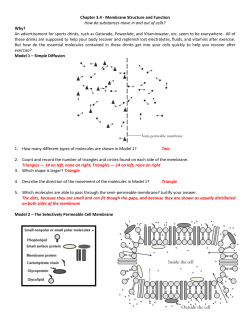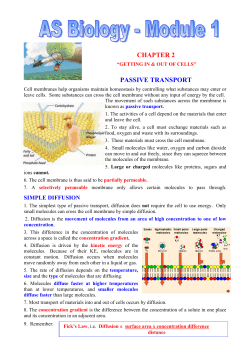
Passive and Active Transport 1. Thermodynamics of transport
Passive and Active Transport 1. Thermodynamics of transport 2. Passive-mediated transport 3. Active transport neuron, membrane potential, ion transport Membranes • Provide barrier function – Extracellular – Organelles • Barrier can be overcome by „transport proteins“ – To mediate transmembrane movements of ions, Na+, K+ – Nutrients, glucose, amino acids etc. – Water (aquaporins) 1) Thermodynamics of Transport • Aout <-> Ain (ressembles a chemical equilibration) • GA - Go‘A = RT ln [A] • ∆GA = GA(in) - GA(out) = RT ln ([A]in/[A]out) • GA: chemical potential of A • Go‘A: chemical potential of standard state of A • If membrane has a potential, i.e., plasma membrane: -100mV (inside negative) then GA is termed the electrochemical potential of A Two types of transport across a membrane: o Nonmediated transport occurs by passive diffusion, i.e., O2, CO2 driven by chemical potential gradient, i.e. cannot occur against a concentration gradient o Mediated transport occurs by dedicated transport proteins 1. Passive-mediated transport/facilitated diffusion: [high] -> [low] 2. Active transport: [low] -> [high] May require energy in form of ATP or in form of a membrane potential 2) Passive-mediated transport Substances that are too large or too polar to diffuse across the bilayer must be transported by proteins: carriers, permeases, channels and transporters A) Ionophores B) Porins C) Ion Channels D) Aquaporins E) Transport Proteins A) Ionophores Organic molecules of divers types, often of bacterial origin => Increase the permeability of a target membrane for ions, frequently antibiotic, result in collapse of target membrane potential by ion equilibration 1. Carrier Ionophore, make ion soluble in membrane, i.e. valinomycin, 104 K+/sec 2. Cannel-forming ionophores, form transmembrane channels, gramicidin A, 107 K+/sec Valinomycin o One of the best characterized ionophores, binds K+ ions o Cyclic peptide with D- and L-Aa o Discrimination between Na+, K+, Li+ ? K+ (r=1.33Å), Na+ (r=0.95Å) Gramicidin A o 15 Aa linear peptide o Alternating D- and L-Aa, all hydrophobic o Dimerizes head-to-head to form channel B) Porins o Membrane spanning proteins with β-barrel structure, with central aqueous channel, diameter ~ 7x11Å ~600 D, little substrate selectivity, E. coli OmpF o Maltoporin, substrate selectivity for maltodextrins, α(1->4)linked glucose oligossaccharide degradation products of starch, greasy slide C) Ion Channels o All organisms have channels for Na+, K+, and Clo Membrane transport of these ions is important for: o Osmotic balance o Signal transduction o Membrane potential o Mammalian cells: extracellular: 150mM Na+, 4mM K+ intracellular: 12mM Na+, 140mM K+ passive diffusion of K+ ions through opening of K+channels from cytosol to extracellular space K+-channels have high selectivity of K+ over Na+ selectivity 104 The K+-channel, KcsA o Streptomyces,Functions as a homotetramer, 158 Aa, 108 ions/sec, Roderick MacKinnon o Selectivity filter allows passage of K+ but not Na+ The selectivity filter o The ion needs to be dehydrated to pass through the most narrow opening of the channel o In the dehydration, water is replaced by hydroxyl groups from the channels amino acids o These hydroxyls will stabilize K+ but not Na+, because Na+ is much smaller than K+ o Cavity in the middle of the channel = middle of the membrane !!! Contains water Ion channels are gated o Channels can be closed and opened upon signal: o Mechanosensitive channels open in response to membrane deformation: touch, sound, osmotic pressure o Ligand-gated channels open in response to extracellular chemical stimulus: neurotransmission o Signal-gated channel, open for example on intracellular binding of Ca2+ o Voltage-gated channel: open in response to membrane potential change, transmission of nerve impulses Nerve impulses are propagated by action potentials o Stimulus of neuron results in opening of Na+ channels -> local depolarization, induces nearby voltage-gated K+ to open as well (repolarization) o Spontaneous closure of channels before N+ / K+ equilibrium is reached o Wave of directional transmission to nearby channels -> propagation of signal along the axon = action potential (~10m/sec), no reduction in amplitude (≠electrical wire), can be repetitive (ms) Time course of an action potential Voltage gated KV channels o Tetramer, S5,S6 ~KcsA, T1 domain in cytosol o Gating by the motion of a protein paddle o S4 helix contains 5 positive charges, spaced by 3 Aa = acts as voltage sensor Model for gating of KV channels o Gating by the motion of a protein paddle, S4 helix o Increase in membrane potential, inside becomes less negative -> baddle moves -> pore opens Ion channels have two gates o One to open and one to close o T1 domain contains inactivation peptide that blocks pore entrance a few ms after V-dependent pore opening Cl- channel differ from cation channels o Present in all cell types. Permit transmembrane movement of chloride ions along concentration gradient: [Cl-] extracellular: 120mM; intracellular 4mM o Homodimer with each 18TMDs D) Aquaporins o Permit rapid rates of water transport across the membrane (kidney, Hg2+), (3 109/sec), Peter Agre (1992); 11 genes in human o AQP1, homotetrameric glycoprotein, 6TMDs, elongated hourglass with central pore o Constriction region, 2.8Å narrow Aquaporins (2) • Only dehydrated water can pass • Only 1 at the time, reorientation of dipol • Selectivity filter similar to KscA • No proton conducting wire allowed E) Transport proteins o Transport proteins alternate between two conformations o Erythrocyte glucose transporter, GLUT1 o Has glucose binding sites on both sites of membrane (propyl on C1 prevents bdg to outer surface, propyl on C6 prevents bdg on inner site) o Assymetric bdg sites o 12 TMDs forms tetramer Transport proteins (2) i.e. GLUT1 i.e. Na+ glucose symporter Lactose permease i.e. oxalate transporter oxalate in, formate out, (Na+-K+)-ATPase Gap Junctions o Form Cell-Cell connections, Connexins form gap junctions o Cells within a organ are in metabolic and physical contact with neighboring cells through gap junctions, 16-20Å pore, 1000 D o Two apposed plasma membrane complexes o Closed by Ca2+ Differentiation between mediated and nonmediated transport 1. Speed and specificity: Mannitol <-> glucose, structurally similar but uptake of glucose is much faster => must be mediated 2. Saturation 3. Competition, with similar substrates 4. Inactivation, heat, protease... mediated Non-mediated 3) Active Transport Transport against a concentration gradient, endergonic process, frequently requires ATP or other energy sources (i.e., transmembrane potential = secondary active transport !) Example: Glucose concentration in blood is around 5mM Glut1 cannot increase the intracellular glucose concentration in the erythrocyte above this 5mM this would require an energy consuming transporter Classes of ATPases All consume intracellular ATP for the transport process: 1. P-type ATPases undergo internal phosporhylation during transport cycle, i.e. Na+, K+, Ca2+ 2. F-type ATPase, proton transportes in mitochondria, synthesize ATP 3. V-type ATPase, acidify a cellular compartment: vacuole, lysosome 4. A-type ATPase transport anions across membranes 5. ABC transporters, ATP-binding cassette, transport wide variety os substances for example ions, small metabolites, lipids, drugs A) (Na+-K +)-ATPase o o Plasma membrane, (αβ)2 tetramer Antiporter that generates charge seperation across membrane -> osmoregulation and nerve excitability 3Na+(in) + 2K+(out) + ATP + H2O -> 3Na+(out) + 2K+(in) + ADP + Pi + + (Na -K )-ATPase o o (2) ATP transiently phosphorylates Asp to form a high energy intermediate = All P-type ATPases While every single reaction step is reversible, the entire transport cycle is not + + (Na -K )-ATPase (3) Step 5 is inhibited by cardiac glycosides -> increase in Na+ Cardiac Glycosides o o Increase intensity of heart muscle contraction Digitalis contains digitoxin Oubain (wabane), arrow poison (East African Ouabio tree) Belong to the steroids, inhibit (Na+-K+)-ATPase Block step 5 -> increase intracellular [Na+] -> stimulate (Na+-Ca2+) antiporter -> increases intracellular Ca2+ and ER stores -> reinforces muscle contraction (higher Ca2+ peaks) B) 2+ Ca -ATPase o Transient [Ca2+] increase triggers many processes, such as: o Muscle contraction o Neurotransmitter release o Glycogen breakdown o Cytosolic [Ca2+] ~0.1 µM, extracellular 1500µM o Concentration gradient (1000x) is maintained by active transport across the plasma membarne and the ER by Ca2+-ATPases, antiport of protons 2+ Ca -ATPase (2) C) ABC transporters are responsible for drug resistance o If anti-cancer drugs do not show any positive effect, this is frequently due to overexpression of the P-glycoprotein, a member of the ABC transporter superfamily or multidrug resistance (MDR) transporters o Built from 4 modules: 2x cytoplasmic nucleotide binding sites, 2x TMDs with 6 helices each, o In bacteria these 4 domains can be coded by 2 or 4 single proteins; in eukaryotes all 4 domains on a single protein o In bacteria, ABC transporters can act as importers or exporters, in eukaryotes only as exporters (?) Structure of an ABC transporter o Sav1866 from Staphylococcus o Homodimer, intertwined subunits CFT is an ABC transporter o CFTR, cystic fibrosis transmembrane conducting channel, is the only ion transporting of the ca 100 known ABC transporters (see Box 3-1) o Allows Cl- ions to flow out of the cell, by ATP hydrolysis o More than 1000 mutations known, most frequent is Phe508 deletion, protein is functional, but improperly folded and degradet in the ER before transport to PM o Homozygous have lung problems, thick mucus in the airways > suffer from chronic lung infections, early death D) Ion Gradient-Driven Active Transport o Free energy of the electrochemical gradient can be utilized to power active transport for example uptake of glucose by symport with Na+ (which is transported down the gradient) Lactose permease requires a proton gradient o E. coli lactose permease (galactoside permease), utilizes proton gradient to symport lactose and H+ The lactose permease o High affinity Bdg site extracellular o Low affinity intracellular o Binds sugar only in combination with proton
© Copyright 2025





















